

Accelerate DevOps and Cloud Native Apps with the Dell Validated Platform for Red Hat OpenShift
Thu, 15 Sep 2022 13:28:43 -0000
|Read Time: 0 minutes
Today we announce the release of the Dell Validated Platform for Red Hat OpenShift. This platform has been jointly validated by Red Hat and Dell, and is an evolution of the design referenced in the white paper “Red Hat OpenShift 4.6 with CSI PowerFlex 1.3.0 Deployment on Dell EMC PowerFlex Family”.
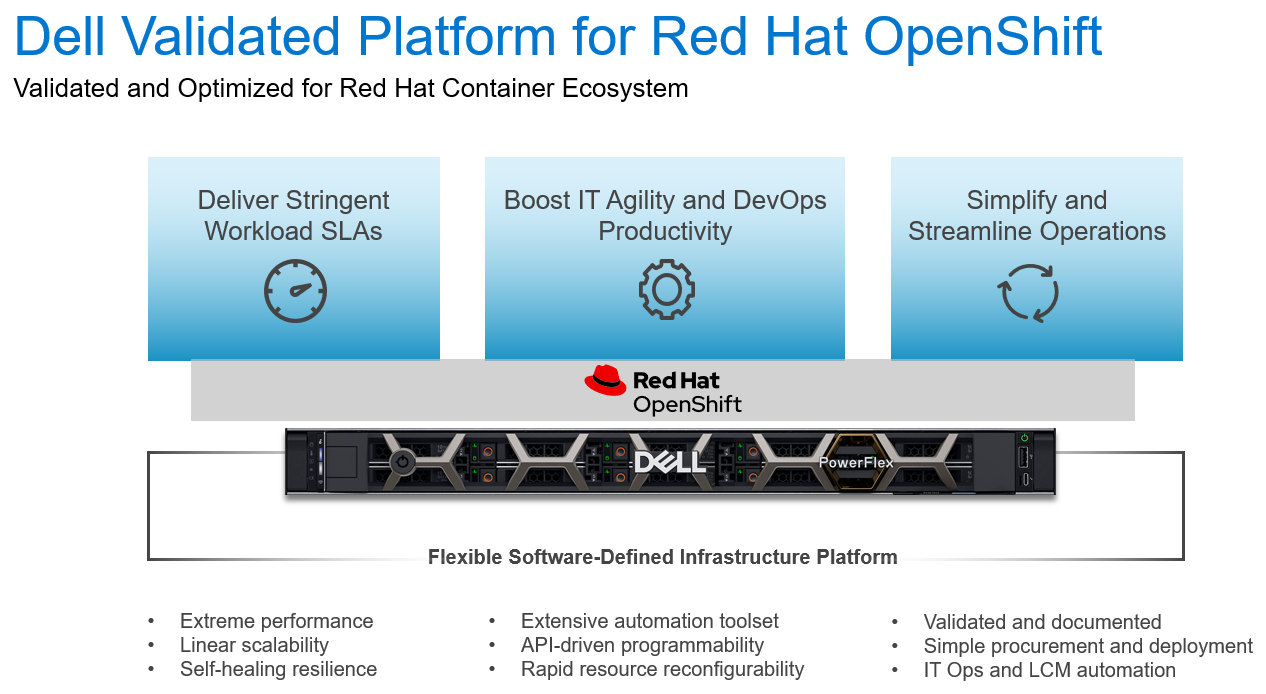
Figure 1: The Dell Validated Platform for Red Hat OpenShift
The world is moving faster and with that comes the struggle to not just maintain, but to streamline processes and accelerate deliverables. We are no longer in the age of semi-annual or quarterly releases, as some industries need multiple releases a day to meet their goals. To accomplish this requires a mix of technology and processes … enter the world of containers. Containerization is not a new technology, but in recent years it has picked up a tremendous amount of steam. It is no longer just a fringe technology reserved for those on the bleeding edge; it has become mainstream and is being used by organizations large and small. However, technology alone will not solve everything. To be successful your processes must change with the technology – this is where DevOps comes in. DevOps is a different approach to Information Technology; it involves a blending of resources usually separated into different teams with different reporting structures and often different goals. It systematically looks to eliminate process bottlenecks and applies automation to help organizations move faster than they ever thought possible. DevOps is not a single process, but a methodology that can be challenging to implement.
Why Red Hat OpenShift?
Red Hat OpenShift is an enterprise-grade container orchestration and management platform based on Kubernetes. While many organizations understand the value of moving to containerization, and are familiar with the name Kubernetes, most don’t have a full grasp of what Kubernetes is and what it isn’t. OpenShift uses their own Kubernetes distribution, and layers on top critical enterprise features like:
- Built-in underlying hardware management and scaling, integrated with Dell iDRAC
- Multi-Cluster deployment, management, and shift-left security enforcement
- Developer Experience – CI/CD, GitOps, Pipelines, Logging, Monitoring, and Observability
- Integrated Networking including ServiceMesh and multi-cluster networking
- Integrated Web Console with distinct Admin and Developer views
- Automated Platform Updates and Upgrades
- Multiple workload options – containers, virtual machines, and serverless
- Operators for extending and managing additional capabilities
All these capabilities mean that you have a full container platform with a rigorously tested and certified toolchain that can accelerate your development, and reduce the costs associated with maintenance and downtime. This is what has made OpenShift the number 1 container platform in the market.
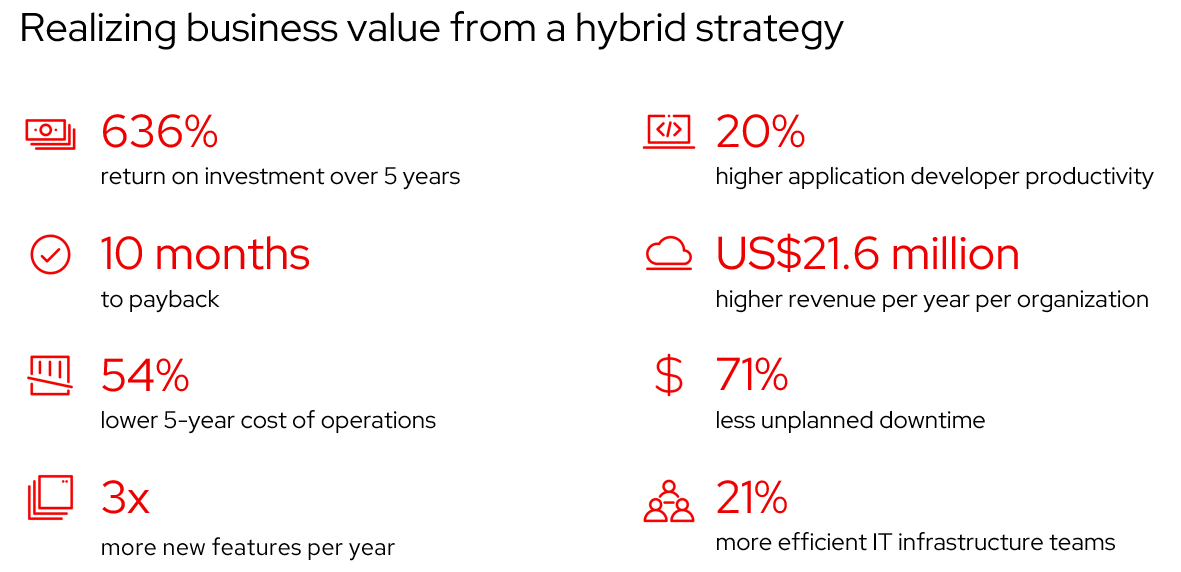
Figure 2: Realizing business value from a hybrid strategy - Source: IDC White Paper, sponsored by Red Hat, "The Business Value of Red Hat OpenShift", doc # US47539121, February 2021.
Meeting the performance needs
Scalable container platforms like Red Hat OpenShift work best when paired with a fast, scalable infrastructure platform, and this is why OpenShift, and Dell PowerFlex are the perfect team. With PowerFlex, organizations can have a single software-defined platform for all their workloads, from bare metal, to virtualized, to containerized. All on a blazing-fast infrastructure that can scale to thousands of nodes. Not to mention the API-driven architecture of PowerFlex fits perfectly in a methodology centered on automation. To help jumpstart customers on their automation journey we have already created robust infrastructure and DevOps automation through our extensive tooling that includes:
- Dell Container Storage Modules (CSM)/Container Storage Interface (CSI) Plugins
- Ansible Modules
- AppSync Integration
Being software-defined means that PowerFlex can deliver linear performance by being able to balance data across all nodes. This ensures that you can spread the work out over the cluster to scale well beyond the limits of the individual hardware components. This also allows PowerFlex to be incredibly resilient, capable of seamlessly recovering from individual component or node failures.
Putting it all together
Introducing the Dell Validated Platform for Red Hat OpenShift, the latest collaboration in the long 22-year partnership between Red Hat and Dell. This platform brings together the power of Red Hat OpenShift with the flexibility and performance of Dell PowerFlex into a single package.

Figure 3: The Dell Validated Platform for Red Hat OpenShift Architecture
This platform uses PowerFlex in a 2-tier architecture to give you optimal performance, and the ability to scale storage and compute independently, up to thousands of nodes. We are also taking advantage of Red Hat capabilities to run PowerFlex Manager and its accompanying services in OpenShift Virtualization to make efficient use of compute nodes and minimize the required hardware footprint.
The combined platform gives you the ability to become more agile and increase productivity through the extensive automation already available, along with the documented APIs to extend that automation or create your own.
This platform has been fully validated by both Dell and Red Hat, so you can run it with confidence. We have also streamlined the ordering process, so the entire platform can be acquired directly from Dell, including the Red Hat software and subscriptions. All of this is implemented using Dell’s ProDeploy services to ensure that the platform is implemented optimally and gets you up and running faster. This means you can start realizing the value of the platform faster, while reducing risk.
If you are interested in getting more information about the Dell Validated Platform for Red Hat OpenShift please contact your Dell representative.
Authors:
Michael Wells, PowerFlex Engineering Technologist
Twitter: @SqlTechMike
LinkedIn
Rhys Oxenham, Director, Customer & Field Engagement
Related Blog Posts

Driving Innovation with the Dell Validated Platform for Red Hat OpenShift and IBM Instana
Wed, 14 Dec 2022 21:20:39 -0000
|Read Time: 0 minutes
“There is no innovation and creativity without failure. Period.” – Brené Brown
In the Information Technology field today, it seems like it’s impossible to go five minutes without someone using some variation of the word innovate. We are constantly told we need to innovate to stay competitive and remain relevant. I don’t want to spend time arguing the importance of innovation, because if you’re reading this then you probably already understand its importance.
What I do want to focus on is the role that failure plays in innovation. One of the biggest barriers to innovation is the fear of failure. We have all experienced some level of failure in our lives, and the costly mistakes can be particularly memorable. To create a culture that fosters innovation, we need to create an environment that reduces the costs associated with failure – these can be financial costs, time costs, or reputation costs. This is why one of the core tenets of modern application architecture is “fail fast”. Put simply, it means to identify mistakes quickly and adjust. The idea is that a flawed process or assumption will cost more to fix the longer it is present in the system. With traditional waterfall processes, that flaw could be present and undetected for months during the development process, and in some cases, even make it through to production.
While the benefits of fail fast can be easy to see, implementing it can be a bit harder. It involves streamlining not just the development process, but also the build process, the release process, and having proper instrumentation all the way through from dev to production. This last part, instrumentation, is the focus of this article. Instrumentation means monitoring a system to allow the operators to:
- See current state
- Identify application performance
- Detect when something is not operating as expected
While the need for instrumentation has always been present, developers are often faced with difficult timelines and the first feature areas that tend to be cut are testing and instrumentation. This can help in the short term, but it often ends up costing more down the road, both financially and in the end-user experience.
IBM Instana is a tool that provides observability of complete systems, with support for over 250 different technologies. This means that you can deploy Instana into the environment and start seeing valuable information without requiring any code changes. If you are supporting web-based applications, you can also take things further by including basic script references in the code to gain insights from client statistics as well.
Announcing Support for Instana on the Dell Validated Platform for Red Hat OpenShift
Installing IBM Instana into the Dell Validated Platform for Red Hat OpenShift can be done by Operator, Helm Chart, or YAML File.
The simplest way is to use the Operator. This consists of the following steps:
- Create the instana-agent project
- Set the policy permissions for the instana-agent service account
- Install the Operator
- Apply the Operator Configuration using a custom resource YAML file
You can configure IBM Instana to point to IBM’s cloud endpoint. Or for high security environments, you can choose to connect to a private IBM Instana endpoint hosted internally.
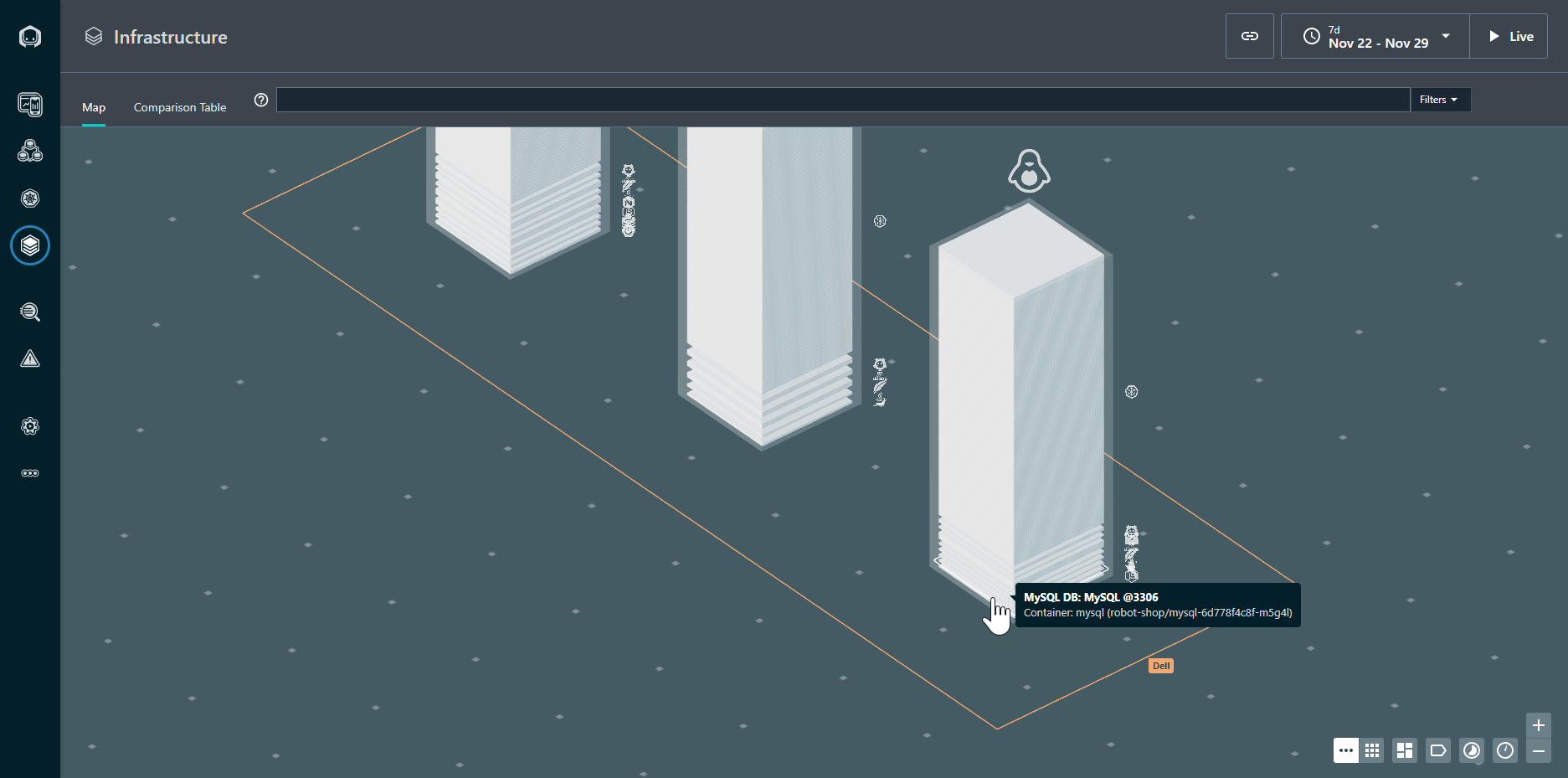
Figure 1. Infrastructure view of the OpenShift Cluster
Once configured, the IBM Instana agent starts sending data to the endpoint for analysis. The graphical view in Figure 1 shows the overall health of the Kubernetes cluster, and the node on which each resource is located. The resources in a normal state are gray: any resource requiring attention would appear in a different color.
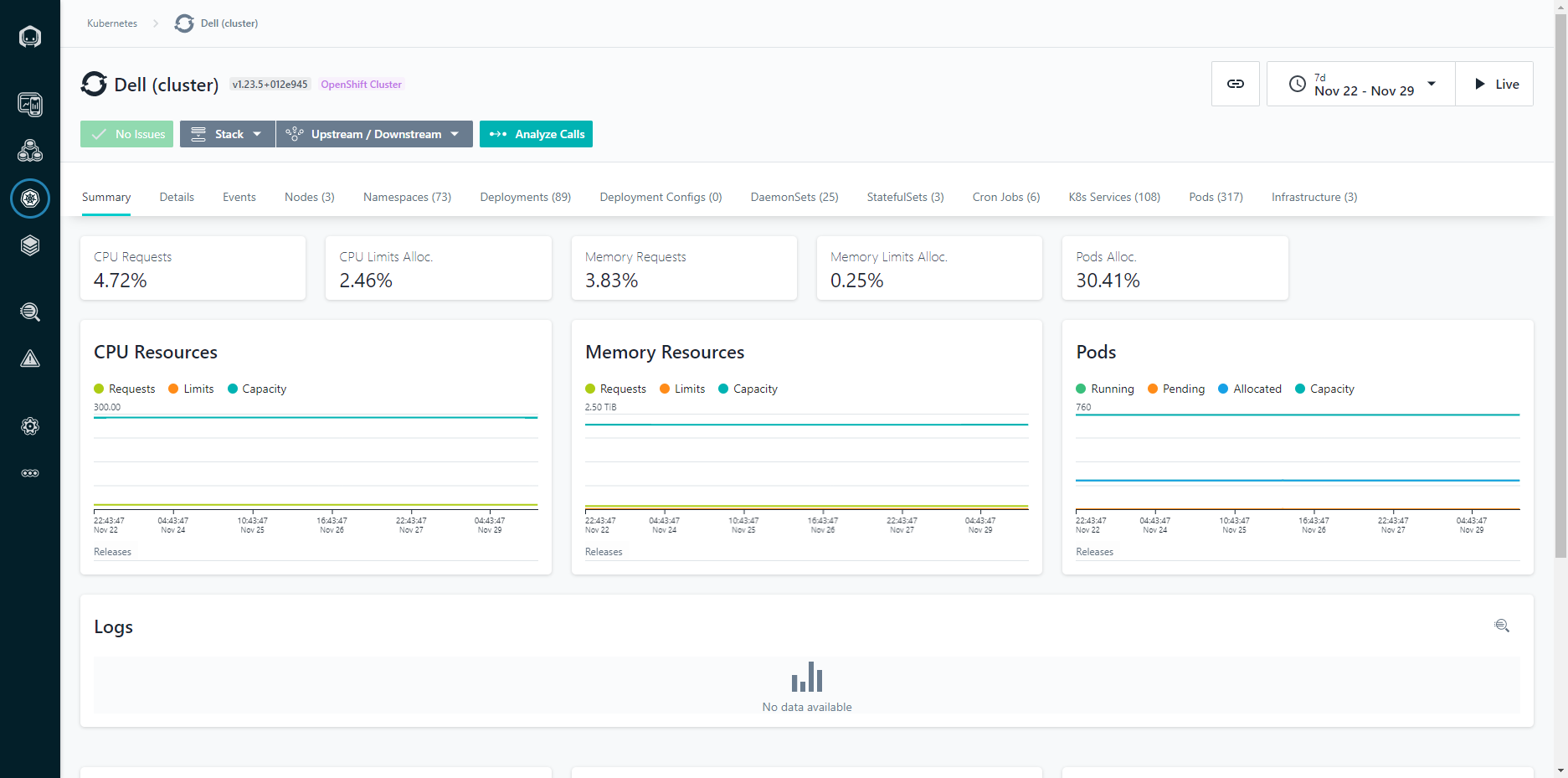
Figure 2: Cluster View
We can also see the metrics across the cluster, including CPU and Memory statistics. The charts are kept in time sync, so if you highlight a given area or narrow the time period, all of the charts remain in the same context. This makes it easy to identify correlations between different metrics and events.

Figure 3: Application Calls View
Looking at the application calls allows you to see how a given application is performing over time. Being able to narrow down to a one second granularity means that you can actually follow individual calls through the system and see things like the parameters passed in the call. This can be incredibly helpful for troubleshooting intermittent application issues.
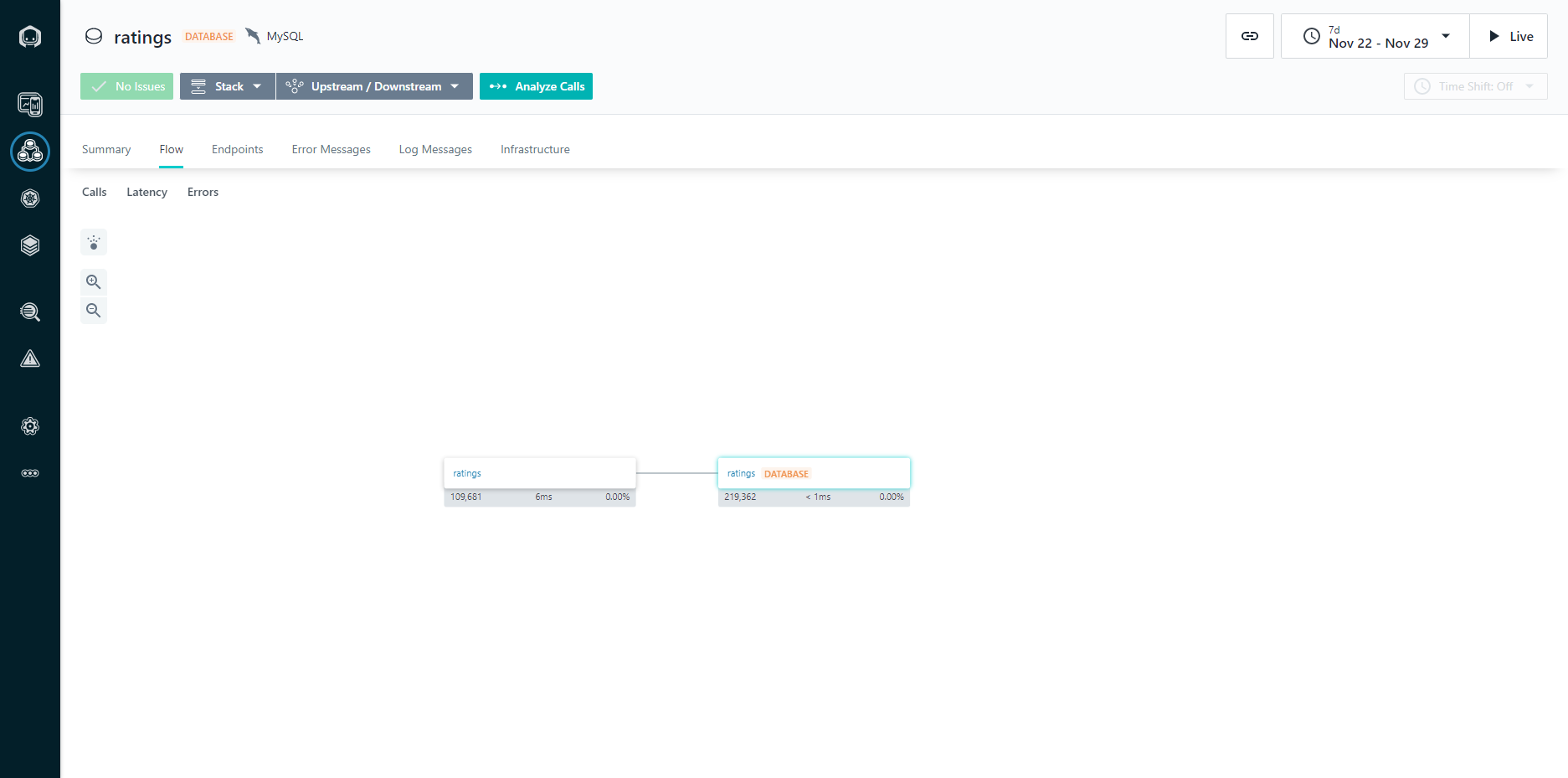
Figure 4: Application Dependencies View
The dependencies view gives you a graphical representation of all the components within a system and how they relate to each other, in a dependency diagram. This is critically important in modern application design because as you implement a larger number of more focused services, often created by different DevOps teams, it can be difficult to keep track of what services are being composed together.
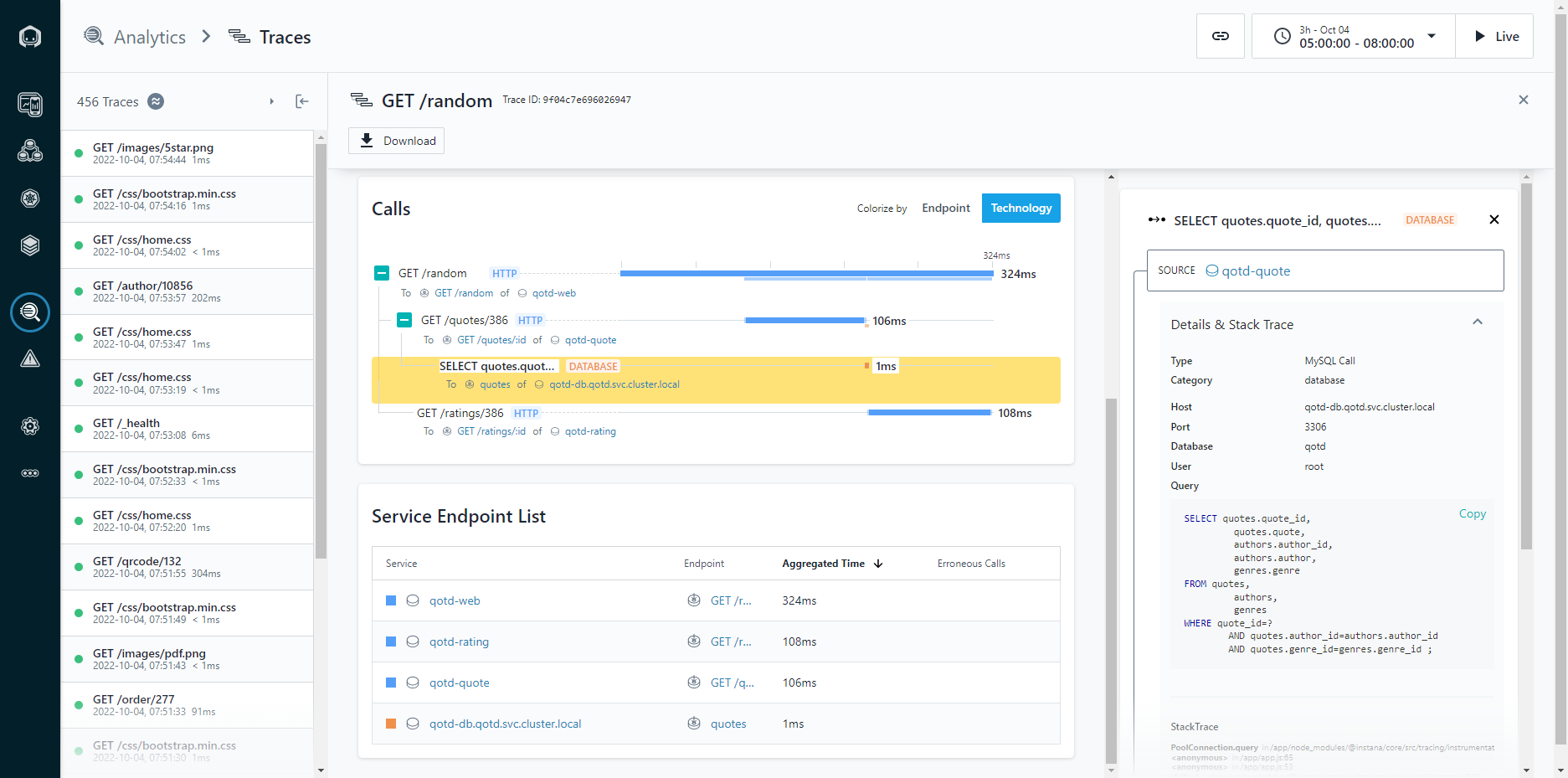
Figure 5: Application Stack Traces
The application stack trace allows you to walk the stack of an application to see what calls were made, and how much time each call took to complete. Knowing that a page load took five seconds can help indicate a problem, but being able to walk the stack and identify that 4.8 seconds was spent running a database query (and exactly what query that was) means that you can spend less time troubleshooting, because you already know exactly what needs to be fixed.
For more information about the Dell Validated Platform for Red Hat OpenShift, see our launch announcement: Accelerate DevOps and Cloud Native Apps with the Dell Validated Platform for Red Hat OpenShift | Dell Technologies Info Hub.
Author: Michael Wells, PowerFlex Engineering Technologist
Twitter: @SqlTechMike
LinkedIn

A Simple Poster at NVIDIA GTC – Running NVIDIA Riva on Red Hat OpenShift with Dell PowerFlex
Fri, 15 Mar 2024 21:45:09 -0000
|Read Time: 0 minutes
A few months back, Dell and NVIDIA released a validated design for running NVIDIA Riva on Red Hat OpenShift with Dell PowerFlex. A simple poster—nothing more, nothing less—yet it can unlock much more for your organization. This design shows the power of NVIDIA Riva and Dell PowerFlex to handle audio processing workloads.
What’s more, it will be showcased as part of the poster gallery at NVIDIA GTC this week in San Jose California. If you are at GTC, we strongly encourage you to join us during the Poster Reception from 4:00 to 6:00 PM. If you are unable to join us, you can view the poster online from the GTC website.
For those familiar with ASR, TTS, and NMT applications, you might be curious as to how we can synthesize these concepts into a simple poster. Read on to learn more.
NVIDIA Riva
For those not familiar with NVIDIA Riva, let’s start there.
NVIDIA Riva is an AI software development kit (SDK) for building conversational AI pipelines, enabling organizations to program AI into their speech and audio systems. It can be used as a smart assistant or even a note taker at your next meeting. Super cool, right?
Taking that up a notch, NVIDIA Riva lets you build fully customizable, real-time conversational AI pipelines, which is a fancy way of saying it allows you to process speech in a bunch of different ways including automatic speech recognition (ASR), text-to-speech (TTS), and neural machine translation (NMT) applications:
- Automatic speech recognition (ASR) – this is essentially dictation. Provide AI with a recording and get a transcript—a near perfect note keeper for your next meeting.
- Text-to-speech (TTS) – a computer reads what you type. In the past, this was often in a monotone voice. It’s been around for more than a couple of decades and has evolved rapidly with more fluid voices and emotion.
- Neural machine translation (NMT) – this is the translation of spoken language in near real-time to a different language. It is a fantastic tool for improving communication, which can go a long way in helping organizations extend business.
Each application is powerful in its own right, so think about what’s possible when we bring ASR, TTS, and NMT together, especially with an AI-backed system. Imagine having a technical support system that could triage support calls, sounded like you were talking to an actual support engineer, and could provide that support in multiple languages. In a word: ground-breaking.
NVIDIA Riva allows organizations to become more efficient in handling speech-based communications. When organizations become more efficient in one area, they can improve in other areas. This is why NVIDIA Riva is part of the NVIDIA AI Enterprise software platform, focusing on streamlining the development and deployment of production AI.
I make it all sound simple, however those creating large language models (LLMs) around multilingual speech and translation software know it’s not so. That’s why NVIDIA developed the Riva SDK.
The operating platform also plays a massive role in what can be done with workloads. Red Hat OpenShift enables AI speech recognition and inference with its robust container orchestration, microservices architecture, and strong security features. This allows workloads to scale to meet the needs of an organization. As the success of a project grows, so too must the project.
Why is Storage Important
You might be wondering how storage fits into all of this. That’s a great question. You’ll need high performance storage for NVIDIA Riva. After all, it’s designed to process and/or generate audio files and being able to do that in near real-time requires a highly performant, enterprise-grade storage system like Dell PowerFlex.
Additionally, AI workloads are becoming mainstream applications in the data center and should be able to run side by side with other mission critical workloads utilizing the same storage. I wrote about this in my Dell PowerFlex – For Business-Critical Workloads and AI blog.
At this point you might be curious how well NVIDIA Riva runs on Dell PowerFlex. That is what a majority of the poster is about.
ASR and TTS Performance
The Dell PowerFlex Solutions Engineering team did extensive testing using the LibriSpeech dev-clean dataset available from Open SLR. With this data set, they performed automatic speech recognition (ASR) testing using NVIDIA Riva. For each test, the stream was increased from 1 to 64, 128, 256, 384, and finally 512, as shown in the following graph.
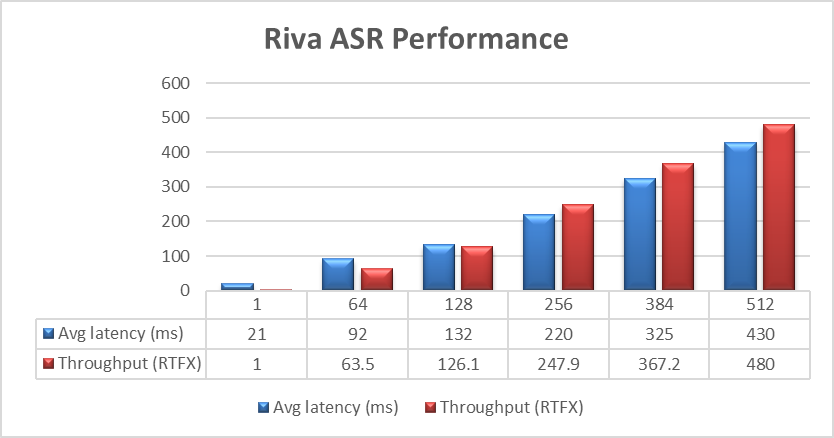 Figure 1. NVIDIA Riva ASR Performance
Figure 1. NVIDIA Riva ASR Performance
The objective of these tests is to have the lowest latency with the highest throughput. Throughput is measured in RTFX, or the duration of audio transcribed divided by computation time. During these tests, the GPU utilization was approximately 48% without any PowerFlex storage bottlenecks. These results are comparable to NVIDIA’s own findings in in the NVIDIA Riva User Guide.
The Dell PowerFlex Solutions Engineering team went beyond just looking at how fast NVIDIA Riva could transcribe text, also exploring the speed at which it could convert text to speech (TTS). They validated this as well. Starting with a single stream, for each run the stream is changed to 4, 6, 8, and 10, as shown in the following graph.
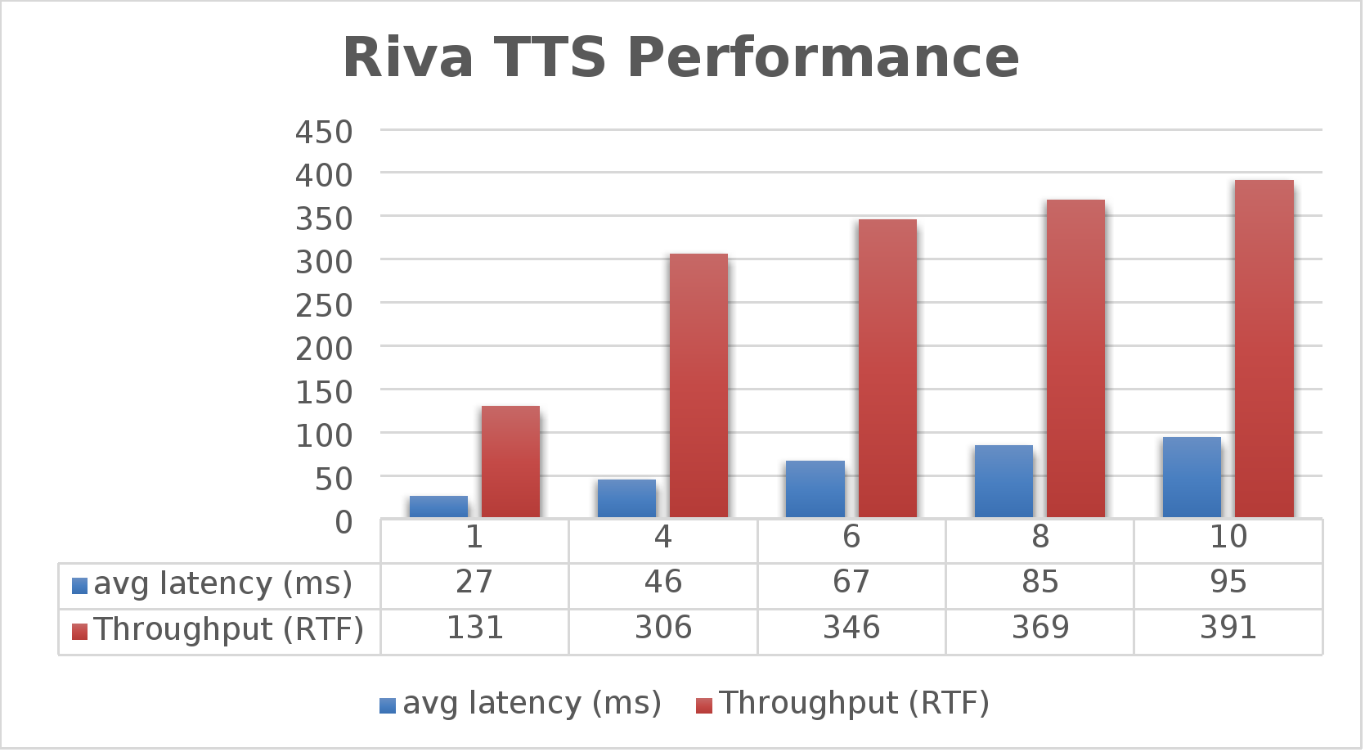 Figure 2. NVIDIA Riva TTS Performance
Figure 2. NVIDIA Riva TTS Performance
Again, the goal is to have a low average latency with a high throughput. The throughput (RTFX) in this case is the duration of audio generated divided by computation time. As we can see, this results in a RTFX throughput of 391 with a latency of 91ms with ten streams. It is also worth noting that during testing, GPU utilization was approximately 82% with no storage bottlenecks.
This is a lot of data to pack into one poster. Luckily, the Dell PowerFlex Solutions Engineering team created a validated architecture that details how all of these results were achieved and how an organization could replicate them if needed.
Now, to put all this into perspective, with PowerFlex you can achieve great results on both spoken language coming into your organization and converting text to speech. Pair this capability with some other generative AI (genAI) tools, like NVIDIA NeMo, and you can create some ingenious systems for your organization.
For example, if an ASR model is paired with a large language model (LLM) for a help desk, users could ask it questions verbally, and—once it found the answers—it could use TTS to provide them with support. Think of what that could mean for organizations.
It's amazing how a simple poster can hold so much information and so many possibilities. If you’re interested in learning more about the research Dell PowerFlex has done with NVIDIA Riva, visit the Poster Reception at NVIDIA GTC on Monday, March 18th from 4:00 to 6:00 PM. If you are unable to join us at the poster reception, the poster will be on display throughout NVIDIA GTC. If you are unable to attend GTC, check out the white paper, and reach out to your Dell representative for more information.
Authors: Tony Foster | Twitter: @wonder_nerd | LinkedIn
Praphul Krottapalli
Kailas Goliwadekar





